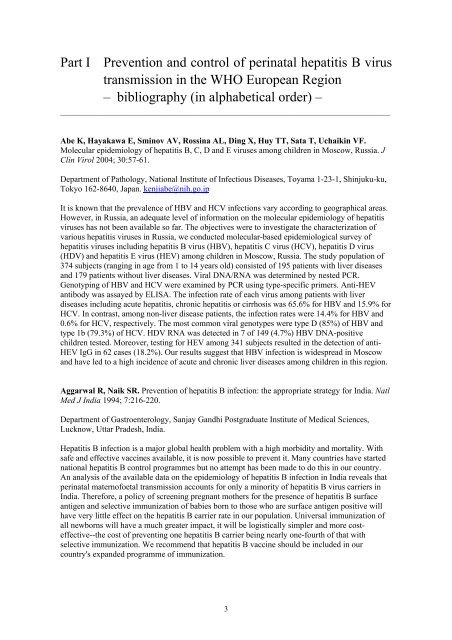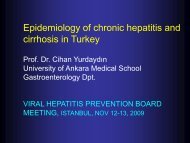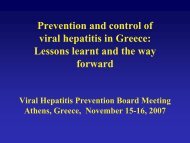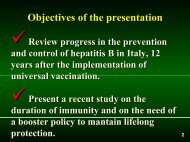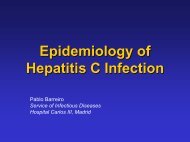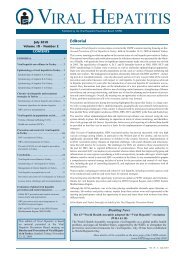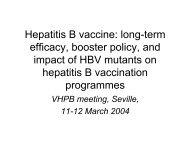Prevention and control of perinatal hepatitis B virus transmission in ...
Prevention and control of perinatal hepatitis B virus transmission in ...
Prevention and control of perinatal hepatitis B virus transmission in ...
Create successful ePaper yourself
Turn your PDF publications into a flip-book with our unique Google optimized e-Paper software.
Part I <strong>Prevention</strong> <strong>and</strong> <strong>control</strong> <strong>of</strong> <strong>per<strong>in</strong>atal</strong> <strong>hepatitis</strong> B <strong>virus</strong><strong>transmission</strong> <strong>in</strong> the WHO European Region– bibliography (<strong>in</strong> alphabetical order) –_______________________________________________________________________________Abe K, Hayakawa E, Sm<strong>in</strong>ov AV, Ross<strong>in</strong>a AL, D<strong>in</strong>g X, Huy TT, Sata T, Uchaik<strong>in</strong> VF.Molecular epidemiology <strong>of</strong> <strong>hepatitis</strong> B, C, D <strong>and</strong> E <strong>virus</strong>es among children <strong>in</strong> Moscow, Russia. JCl<strong>in</strong> Virol 2004; 30:57-61.Department <strong>of</strong> Pathology, National Institute <strong>of</strong> Infectious Diseases, Toyama 1-23-1, Sh<strong>in</strong>juku-ku,Tokyo 162-8640, Japan. kenjiabe@nih.go.jpIt is known that the prevalence <strong>of</strong> HBV <strong>and</strong> HCV <strong>in</strong>fections vary accord<strong>in</strong>g to geographical areas.However, <strong>in</strong> Russia, an adequate level <strong>of</strong> <strong>in</strong>formation on the molecular epidemiology <strong>of</strong> <strong>hepatitis</strong><strong>virus</strong>es has not been available so far. The objectives were to <strong>in</strong>vestigate the characterization <strong>of</strong>various <strong>hepatitis</strong> <strong>virus</strong>es <strong>in</strong> Russia, we conducted molecular-based epidemiological survey <strong>of</strong><strong>hepatitis</strong> <strong>virus</strong>es <strong>in</strong>clud<strong>in</strong>g <strong>hepatitis</strong> B <strong>virus</strong> (HBV), <strong>hepatitis</strong> C <strong>virus</strong> (HCV), <strong>hepatitis</strong> D <strong>virus</strong>(HDV) <strong>and</strong> <strong>hepatitis</strong> E <strong>virus</strong> (HEV) among children <strong>in</strong> Moscow, Russia. The study population <strong>of</strong>374 subjects (rang<strong>in</strong>g <strong>in</strong> age from 1 to 14 years old) consisted <strong>of</strong> 195 patients with liver diseases<strong>and</strong> 179 patients without liver diseases. Viral DNA/RNA was determ<strong>in</strong>ed by nested PCR.Genotyp<strong>in</strong>g <strong>of</strong> HBV <strong>and</strong> HCV were exam<strong>in</strong>ed by PCR us<strong>in</strong>g type-specific primers. Anti-HEVantibody was assayed by ELISA. The <strong>in</strong>fection rate <strong>of</strong> each <strong>virus</strong> among patients with liverdiseases <strong>in</strong>clud<strong>in</strong>g acute <strong>hepatitis</strong>, chronic <strong>hepatitis</strong> or cirrhosis was 65.6% for HBV <strong>and</strong> 15.9% forHCV. In contrast, among non-liver disease patients, the <strong>in</strong>fection rates were 14.4% for HBV <strong>and</strong>0.6% for HCV, respectively. The most common viral genotypes were type D (85%) <strong>of</strong> HBV <strong>and</strong>type 1b (79.3%) <strong>of</strong> HCV. HDV RNA was detected <strong>in</strong> 7 <strong>of</strong> 149 (4.7%) HBV DNA-positivechildren tested. Moreover, test<strong>in</strong>g for HEV among 341 subjects resulted <strong>in</strong> the detection <strong>of</strong> anti-HEV IgG <strong>in</strong> 62 cases (18.2%). Our results suggest that HBV <strong>in</strong>fection is widespread <strong>in</strong> Moscow<strong>and</strong> have led to a high <strong>in</strong>cidence <strong>of</strong> acute <strong>and</strong> chronic liver diseases among children <strong>in</strong> this region.Aggarwal R, Naik SR. <strong>Prevention</strong> <strong>of</strong> <strong>hepatitis</strong> B <strong>in</strong>fection: the appropriate strategy for India. NatlMed J India 1994; 7:216-220.Department <strong>of</strong> Gastroenterology, Sanjay G<strong>and</strong>hi Postgraduate Institute <strong>of</strong> Medical Sciences,Lucknow, Uttar Pradesh, India.Hepatitis B <strong>in</strong>fection is a major global health problem with a high morbidity <strong>and</strong> mortality. Withsafe <strong>and</strong> effective vacc<strong>in</strong>es available, it is now possible to prevent it. Many countries have startednational <strong>hepatitis</strong> B <strong>control</strong> programmes but no attempt has been made to do this <strong>in</strong> our country.An analysis <strong>of</strong> the available data on the epidemiology <strong>of</strong> <strong>hepatitis</strong> B <strong>in</strong>fection <strong>in</strong> India reveals that<strong>per<strong>in</strong>atal</strong> matern<strong>of</strong>oetal <strong>transmission</strong> accounts for only a m<strong>in</strong>ority <strong>of</strong> <strong>hepatitis</strong> B <strong>virus</strong> carriers <strong>in</strong>India. Therefore, a policy <strong>of</strong> screen<strong>in</strong>g pregnant mothers for the presence <strong>of</strong> <strong>hepatitis</strong> B surfaceantigen <strong>and</strong> selective immunization <strong>of</strong> babies born to those who are surface antigen positive willhave very little effect on the <strong>hepatitis</strong> B carrier rate <strong>in</strong> our population. Universal immunization <strong>of</strong>all newborns will have a much greater impact, it will be logistically simpler <strong>and</strong> more costeffective--thecost <strong>of</strong> prevent<strong>in</strong>g one <strong>hepatitis</strong> B carrier be<strong>in</strong>g nearly one-fourth <strong>of</strong> that withselective immunization. We recommend that <strong>hepatitis</strong> B vacc<strong>in</strong>e should be <strong>in</strong>cluded <strong>in</strong> ourcountry's exp<strong>and</strong>ed programme <strong>of</strong> immunization.3


